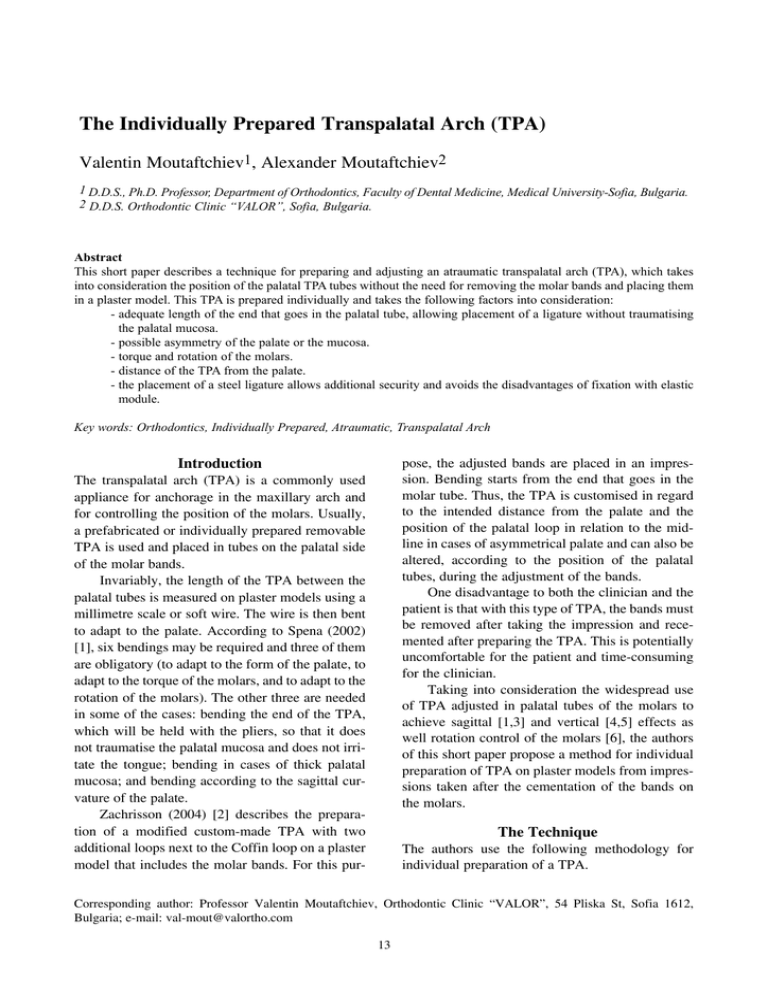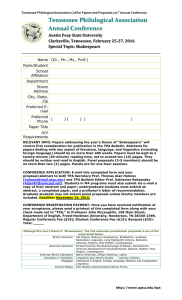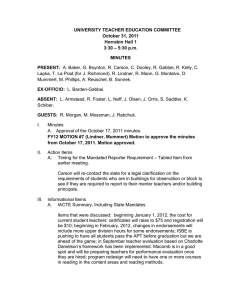The Individually Prepared Transpalatal Arch (TPA)
advertisement

The Individually Prepared Transpalatal Arch (TPA) Valentin Moutaftchiev1, Alexander Moutaftchiev2 1 D.D.S., Ph.D. Professor, Department of Orthodontics, Faculty of Dental Medicine, Medical University-Sofia, Bulgaria. 2 D.D.S. Orthodontic Clinic “VALOR”, Sofia, Bulgaria. Abstract This short paper describes a technique for preparing and adjusting an atraumatic transpalatal arch (TPA), which takes into consideration the position of the palatal TPA tubes without the need for removing the molar bands and placing them in a plaster model. This TPA is prepared individually and takes the following factors into consideration: - adequate length of the end that goes in the palatal tube, allowing placement of a ligature without traumatising the palatal mucosa. - possible asymmetry of the palate or the mucosa. - torque and rotation of the molars. - distance of the TPA from the palate. - the placement of a steel ligature allows additional security and avoids the disadvantages of fixation with elastic module. Key words: Orthodontics, Individually Prepared, Atraumatic, Transpalatal Arch Introduction pose, the adjusted bands are placed in an impression. Bending starts from the end that goes in the molar tube. Thus, the TPA is customised in regard to the intended distance from the palate and the position of the palatal loop in relation to the midline in cases of asymmetrical palate and can also be altered, according to the position of the palatal tubes, during the adjustment of the bands. One disadvantage to both the clinician and the patient is that with this type of TPA, the bands must be removed after taking the impression and recemented after preparing the TPA. This is potentially uncomfortable for the patient and time-consuming for the clinician. Taking into consideration the widespread use of TPA adjusted in palatal tubes of the molars to achieve sagittal [1,3] and vertical [4,5] effects as well rotation control of the molars [6], the authors of this short paper propose a method for individual preparation of TPA on plaster models from impressions taken after the cementation of the bands on the molars. The transpalatal arch (TPA) is a commonly used appliance for anchorage in the maxillary arch and for controlling the position of the molars. Usually, a prefabricated or individually prepared removable TPA is used and placed in tubes on the palatal side of the molar bands. Invariably, the length of the TPA between the palatal tubes is measured on plaster models using a millimetre scale or soft wire. The wire is then bent to adapt to the palate. According to Spena (2002) [1], six bendings may be required and three of them are obligatory (to adapt to the form of the palate, to adapt to the torque of the molars, and to adapt to the rotation of the molars). The other three are needed in some of the cases: bending the end of the TPA, which will be held with the pliers, so that it does not traumatise the palatal mucosa and does not irritate the tongue; bending in cases of thick palatal mucosa; and bending according to the sagittal curvature of the palate. Zachrisson (2004) [2] describes the preparation of a modified custom-made TPA with two additional loops next to the Coffin loop on a plaster model that includes the molar bands. For this pur- The Technique The authors use the following methodology for individual preparation of a TPA. Corresponding author: Professor Valentin Moutaftchiev, Orthodontic Clinic “VALOR”, 54 Pliska St, Sofia 1612, Bulgaria; e-mail: val-mout@valortho.com 13 OHDMBSC - Vol. VIII - No. 1 - March, 2009 To prepare a model, an impression is taken from the maxillary arch with bands cemented on the molars. Two lines are drawn with a pencil on the plaster model: a vertical line at the mesial end of the palatal tube and a horizontal line at the occlusal side of the tube (Figure 1). The palatal mid-line is then marked on the model (Figure 2). Next, the cast of the palatal tube is removed with a plaster knife while keeping the drawn lines that clearly show the position and the direction of the tube (Figure 3). Figure 3. Plaster model with removed casts of the palatal tubes and preserved marks. While keeping the Coffin loop centred to the mid-palatal line and at about 1 mm distance from the model, a mark is made on the arm of the wire 11.5 mm below the horizontal line on the model. The wire is the bent perpendicularly distally (Figure 4). The TPA-forming pliers are placed 1-2 mm away from the right-angle bend and the wire is bent back (Figure 5) and squeezed consecutively in the larger and smaller grooves of the pliers (Figure 6). The aim is to prepare accurately the part that will fit in the palatal tube. This is practically impossible without the use of TPA pliers. The wire is then bent back parallel to the arm about 2 mm away from the segment that fits in the palatal tube, cut 3-4 mm down, and the end is polished. Figure 1. Plaster model with lines drawn at the occlusal side and at the mesial end of the palatal tube. Figure 2. Plaster model with marked tubes and palatal mid-line. The preferred Coffin loop (single or with additional loops) is bent from 0.9 mm stainless steel wire. The arms of the wire directed to the molars are bent according to the morphology of the palate, so that the Coffin loop is adapted to the palate. Bending continues until the wire reaches 1-1.5 mm to the horizontal line, delineating the occlusal end of the tube. Figure 4. Segment of the wire coming from the adjusted Coffin spring and bent backwards perpendicularly at the level of the anterior edge of the tube and 1-2 mm below the upper edge. The ready segment is oriented according to the delineation of the palatal tube so that it touches the 14 OHDMBSC - Vol. VIII - No. 1 - March, 2009 plaster wall. In this position, both the torque and the rotation of the molar are taken into consideration (Figure 7). Figure 8. TPA adjusted in the plaster model. The resulting TPA usually requires minimal clinical adjustments to fit passively in the palatal tubes. Initially, one end is placed in position and the distance of the wire from the palate and the position of the other end are checked. If needed the, the TPA is adjusted, so that when one of the ends is placed in position, the other end is parallel to the molar tube and at the same height, and the TPA is about 1 mm from the palate. The TPA can be activated if indicated. After both ends of the TPA are placed in the molar bands, they protrude by 1-2 mm (Figure 9). This is due to the distance the pliers were placed away from the right-angle bend, as the width of the pliers is equal to the width of the tube. No more than 2 mm of the wire should show, because it might traumatise the mucosa, especially when the palatal tube is close to the palatal mucosa. At the same time, when a little of the wire is showing, it allows placement of a ligature that secures the TPA and prevents its displacement. Figure 5. Bending of the wire at the width of the branches of TPA pliers + 1-2 mm. Figure 6. Wire after being squeezed in the TPA pliers. Figure 7. Segment of the TPA adjusted according to the position of the molar. Bending of the opposite side is performed the same way, while keeping the position of the completed segment (Figure 8). Figure 9. End of TPA protruding from the tube of the band and allowing fixation with stainless steel ligature. 15 OHDMBSC - Vol. VIII - No. 1 - March, 2009 Advantages of the Technique palatal tube, and allows placement of a ligature without traumatising the palatal mucosa; - possible asymmetry of the palate or the mucosa; - the torque and rotation of the molars; - the distance of the TPA from the palate; - the placement of a steel ligature allows additional security and avoids the disadvantages of fixation with elastic module. This method of preparing and adjusting a TPA has the following main advantages: z It takes into consideration the position of the palatal TPA tubes without the need for removing the molar bands and placing them in the plaster model. z The TPA is prepared individually and takes into consideration: - the adequate length of the end that goes in the References 1. Spena R. Nonextraction Treatment: An Atlas on Cetlin Mechanics. Birmingham, AL: GAC International, 2002; pp1972. 2. Zachrisson BU. Clinical use of custom-made transpalatal arches—why and how. World Journal of Orthodontics 2004; 5(3): 260-267. 3. Burstone C, Manhartsberger C. Precision lingual arches: passive applications. Journal of Clinical Orthodontics 1988; 22(7): 444-451. 4. Deberardinis M, Stretesky T, Sinha P, Nanda RS. Evaluation of the vertical holding appliance in treatment of high-angle patients. American Journal of Orthodontics and Dentofacial Orthopedics 2000; 117(6): 700-705. 5. Wise JB, Magness WB, Powers JM. Maxillary molar vertical control with the use of transpalatal arches. American Journal of Orthodontics and Dentofacial Orthopedics 1994; 106(4): 403-408. 6. Gündüz E, Zachrisson BU, Hönigl KD, Crismani AG, Bantleon HP. An improved transpalatal bar design. Part I. Comparison of moments and forces delivered by two bar designs for symmetrical molar derotation. The Angle Orthodontist 2003; 73(3): 239-243. 16




